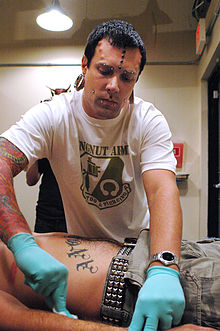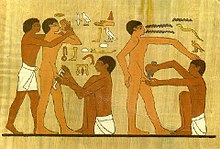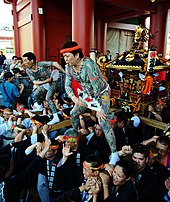Body modification
Body modification ( English Body Modification , also BodMod for short ) is a generic term for various changes in the human body . They are performed for aesthetic reasons or for sexual stimulation and are usually carried out by specialized commercial providers. As a rule, there is no medical indication. In contrast to other types of body design , which achieve changes, for example through superficial painting or through training, body modifications with injurious interventions in the substance of the human body (the skin , sometimes also underlying cartilage and fat tissue ) and with permanent or difficult to reverse making changes. Body modification includes tattoos , piercings , implants as well as brandings, jewelry scars and other scarifications . The differentiation from cosmetic surgery is sometimes not clear. So one is breast augmentation or ribs distance not usually counted to the area Body Modification, other silicone implants does. Likewise, a religiously motivated circumcision would not count. In the specific case, the motive for the intervention decides whether it falls into the category of body modification. In a certain sense, body hair removal could also be understood in a broader sense as a widespread form of body modification.
While the body modification requires an intervention in the existing physical integrity, the adornment of the body in the narrowest sense and in a (fuzzy) differentiation from body adornment are the customs and objects that are attached to the body and clothing of the person and serve as ornament. Jewelry, but also body modification, refers to the elements that animals or plants form for analogous purposes as a means of communication in the broadest sense.
history
Most of the forms go back to traditional rituals that have been practiced by different peoples for centuries. On the other hand, forms of body modification were found relatively late in Europe. Tattoos have been known in Europe for centuries. With the discovery of Polynesia , the art of tattooing received its first boom. At that time, genital piercings from the region around the Indian Ocean were rarely performed on Europeans. At the end of the 19th century, the art of tattooing experienced a second boom, which came to a standstill again during the two world wars. For a short time after the Second World War there were no full-time tattoo artists in Germany, and the piercing trade was almost completely forgotten.
It wasn't until the 1970s that tattoos experienced a new boom. Since 1980 and especially in the 1990s, piercing experienced a great boom; Other forms of body modification also came to Germany. Today there is a diverse scene, the extreme body modifications ( splitting the tongue , subincision ) are still rare in Europe and largely restricted to North America, where the subculture of the modern primitives also developed.
to form
The best-known and most traditional forms in the West are tattoos and piercings. In addition, there are other forms of body modification, some of which have only recently become widespread in Western countries.
Piercing
Here, piercing jewelry in the form of rings or rods is attached to various parts of the human body through the skin and underlying fatty or cartilage tissue. Piercings can be attached to a wide variety of parts of the body. As a rule, these are skin folds or body openings (mouth, nose, ear, genitals); if the entry and exit points are on the same level, we speak of surface piercings . Piercings can be widened to a large diameter .
Transdermals
Transdermals, also known as transdermal implants, are implants in which a small metal plate is placed under the skin. There is a threaded rod on this, which is used to attach various jewelry attachments. A special form are so-called microdermal or dermal anchors. These are transdermals with a relatively small implant surface, which are very popular due to their fast healing time. Transdermals are visually very similar to surface piercings.
tattoo
A tattoo, also known as a tatoo or tattoo, is a motif that is applied to the skin with ink or other coloring agents. For this purpose, the color is usually pierced with the help of a tattoo machine through one or more needles (depending on the desired effect) into the second layer of skin and a picture or text is drawn in the process.
Scarification
Scarification describes the application of decorative scars to the skin. Depending on the method, the terms cutting are also used for the creation of scars through cuts or branding for external burn marks.
clipping
Circumcision involves the removal of tissue from the genitals . In general, when using the term, circumcision in men is meant. This results in a partial or complete removal of the penile foreskin . But women can also undergo various surgical changes to the vulva , such as labioplasty (usually a reduction or removal of the labia ) or reduction of the clitoral hood . In Africa, the so-called circumcision of female genitals is widespread, a generic term under which various (mostly involuntary) interventions are summarized, which are usually carried out for reasons of social sexual morality .
Other forms
In addition to the modifications mentioned, which are relatively common, there are other, more rare forms of body modification. For example, certain parts of the body can be split, for example the tongue splitting or the subincision and bifurcation , which is more common among indigenous peoples , in which the front part of the urethra is split. Furthermore, it comes for the insertion of ornamental implants, so-called implants or temporary visible Bagelheads .
Furthermore, there are various forms of body modification that are or were limited to certain ethnicities or cultures and are not practiced in the West, for example lotus foot , chest stirrup , plate lips , lip stake , (see also: lip enlargement ), skull deformation or padding .
Motifs
A person's motives for permanently changing their body through physical intervention are multifaceted. They vary between individuals and cultures.
Aesthetic motifs

The most common motif nowadays is simply the embellishment and adornment of the body. What can be viewed as beautiful in each case is strongly influenced by social and cultural guidelines and manifests itself in the prevailing ideal of beauty . This differs depending on the era and culture. With regard to body modifications, it is striking that since the second half of the 20th century, the ideal of beauty in Western cultures has been increasingly inspired by influences from indigenous peoples . Numerous forms of body modification such as piercing or branding, which the younger generation now regard as beautiful and aesthetic and which are widely accepted, were socially ostracized in the West a few decades ago and regarded as “primitive tribal rituals”. Furthermore, the beauty factor plays a much larger role in modern society than it used to be. The choice of partner now takes place free of class and role conventions, the media confronts you with perfect role models and appearance is more important than before in professional contexts, which can lead to exclusion and even lookism .
Ritual motifs

In many archaic cultures, changing the human body is a ritual intervention that serves as an initiation ritual . The modification usually takes place in late childhood or early adolescence and represents the transition to the adult world. An essential component of the ritual is enduring and transcending the pain associated with the intervention. Body modifications are also used to distinguish it from other tribes.
Occasionally, some scientists also regard today's forms of body modification as a characteristic of auto-initiation : in today's, de-ritualized world, the need to mark the transition to adulthood itself is met. This is supported by the fact that the majority of first piercings or tattoos are done between the ages of 16 and 24 years. A piercing done for an 18th birthday can symbolize the end of adolescence .
Cultural identity
Body modification is a means of showing belonging to a certain cultural or subcultural group. These have been different tribes or clans in the past and up to the present. The modifications between the tribes can differ - a lip plate or padaung indicates belonging to a particular tribe - and the same modifications can vary in slight nuances and provide information about the origin. In many neighboring African tribes, for example, scarification or tattoos are widespread, with patterns or motifs encoding the tribal affiliation. With the Japanese yakuza , too , tattoos serve to demonstrate membership of the association.
Similar to a wedding ring in Western society, body modifications in some traditional cultures can serve as a symbol of the togetherness of men and women. This applies in particular to genital piercings .
In today's modern society it is rather subcultural movements with which identification takes place. Piercing has found its way into western culture since the 1980s. At that time, the body modification was seen as a sign of rebellion against the establishment and counterculture. With the meanwhile widespread use by all sections of the population and acceptance in society, the aspect of demarcation from the mainstream has lost its importance. Piercings are now valued primarily for their aesthetic component in the West.
Functional reasons
Some modifications have functional aspects beyond their aesthetic and cultural significance. These can be of different nature and lead to certain areas of life being improved. For example, the circumcision practiced by many cultures is attributed to an improvement in hygiene and a lower risk of infection with sexually transmitted diseases, although this is controversial and the study situation is not uniform. Furthermore, circumcision leads to decreased sexual sensitivity. The subincision common among the Aborigines can be seen as a measure of birth control . Various genital piercings , such as the apadravya for men or the clitoral hood piercing for women, are intended to intensify the stimulation during sexual intercourse and to intensify the sexual experience.
Controversy
Any body modification is at risk of unwanted effects on the body, especially if modifications (for example by unlicensed surgeons) are carried out outside of a hospital or even at home, which can be life-threatening and is illegal in some countries.
The attempt to imitate other cultures or peoples in order to resemble them is controversial, for example that Asians have their epicanthus folds operated on to imitate European, non-Asian eyes, the skin is lightened by dyes or operations or Africans straighten their hair and theirs Seek to alter noses through rhinoplasty .
Critics argue that the attempt to artificially change the natural shape of the body can lead to distortions and mutilations, and that extreme forms of body modification in particular can be a symptom of a mental illness such as dysmorphophobia or uncontrolled vanity.
See also
- Skull manipulation among indigenous peoples of Latin America
- Body Modification E-Zine , a large internet portal on the subject of body modification
- Ideal of beauty
- Tooth jewelry
- Grill (jewelry)
- Splitting the tongue
- Pubic hair removal
- Lizardman
Filmography
- 2005: Modify , directed by Jason Gary and Greg Jacobson.
literature
- Rhea Kälin: Body Modification. Psychological aspects of piercings and other body modifications. University of Zurich, 2008, online PDF file
- Erich Kasten : Body Modification. Psychological and medical aspects of piercing, tattoo, self-harm and other body alterations. Reinhardt, Munich / Basel 2006, ISBN 3-497-01847-3 .
- Tobias Prüwer: Drawn for life. Body modification and body discourses. Parodos, Berlin 2012, ISBN 978-3-938880-49-4 .
Web links
- www.Body-Modification.org - German website on the subject of body modifications
- www.BodyMod.org - website on the subject of body modifications
- Modify the Internet Movie Database (English)
Individual evidence
- ↑ a b c d e f Erich Kasten: Body Modification. Psychological and medical aspects of piercing, tattoo, self-harm and other body alterations. Reinhardt, Munich / Basel 2006, ISBN 3-497-01847-3 .
- ↑ Kendra Jane: An Exploration of Pain. ( Memento from February 3, 2015 in the web archive archive.today ) In: The Point - Quarterly journal of the Association of Professional Piercers. No. 61, December 6, 2012.
- ↑ R. Rowan Childe: Male genital modification: A sexual selection interpretation. In: Human Nature. Vol. 7, No. 2, 1996, pp. 189-215. doi: 10.1007 / BF02692110





